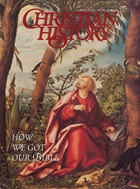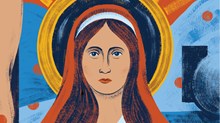There have been many crises in the history of Christianity. Few have been greater than that initiated by the emperor Diocletian on February 23, 303. This last great persecution by the Roman Empire was slow in coming, and it was some time before its full seriousness was felt. Then it had become violent.
The main enemy the state had to face was neither the Christian buildings nor even the Christians themselves but the books they possessed. If these were not destroyed, they might be like buried seeds and put forth new life later on. Thus, many copies of the Scriptures were destroyed.
When the persecution died down and discipline was restored to the church, the most important moral problem was what should be done about the traditores, those who had “handed over” sacred books for destruction. (Biblical studies are poorer in the material at their disposal because of the persecution of Diocletian.) But not all Christians were traditores. Copies of the Scriptures were buried and hidden and then brought out again.
This was the last great persecution. Its failure led to the victory of the church. In 306 Constantine—later known to history as the first Christian emperor—was hailed as Augustus by his troops at York. In 312 he was greeted with the same title by the Senate in Rome. In 313 there was issued the Edict of Milan proclaiming freedom of worship. In 324 Constantine became sole emperor.
The victory of the church was complete. Christianity now was not merely a tolerated religion but one that had special official approval. It became fashionable to join the church. There was, naturally, need for many more church buildings. There was also need for many more Bibles.
Fifty Bibles for the Emperor
The center of gravity in the Empire was no longer at Rome but much further east in Byzantium. Constantine rebuilt it as a new Rome, and for the churches of the new “Constantinople,” the emperor himself, in a.d. 332, ordered fifty vellum Bibles from Eusebius of Caesarea:
“I have thought it expedient to instruct your Intelligence that you should command to be written fifty volumes on prepared vellum, easy to read and conveniently portable, by professional scribes with an exact understanding of their craft—volumes, that is to say, of the Holy Scriptures, the provision and use of which is, as you are aware, most necessary for the instruction of the church.
“Letters have been dispatched from our Clemency to the accountant of the province, advising him to supply everything requisite for the production of the books, and it will be your care to ensure that they are prepared as quickly as possible.
“Using the authority of this letter you should commandeer two public carriages for their transport, for by such means will these fine volumes be most readily brought before our eyes, this duty being performed by one of the deacons of your church, who on reaching our presence will experience our liberality.”
It would be exciting if we could claim that in some museum there was one of the actual Bibles ordered by Constantine for the churches in his new capital. No such claim can be made. What we can say, however, is that books of this character and date do exist. They are our primary authority for the text of the Greek Bible.
Other cities emulated Constantinople in endeavoring to secure the best copies money could buy. In earlier days, a church that possessed the Scriptures would own them in parts. The New Testament would be in one section for the Gospels, a second section for the epistles of Saint Paul. A third section headed Acts would also contain, very likely, the other New Testament epistles, or some of them. And there might be a fourth section containing the Revelation. But now whole Bibles were made, to become not only a means of instruction but a source of ecclesiastical and civic pride.
The First Full Bibles
Three imposing volumes have survived—none of them complete—from this period, the Codex Vaticanus, the Codex Sinaiticus, and the Codex Alexandrinus. The first, as its name implies, is in the Library of the Vatican, where it has been at least since 1481. Codex Sinaiticus is in the British Museum. It was bought in 1933 from the Soviet Government. The Codex Alexandrinus is also in the British Museum. It reached England in 1627.
These great manuscripts are called “uncials,” because they were written in capital letters throughout. (When a running hand was later adopted, the resulting manuscripts are called “cursives” or “minuscules.”)
In uncial writing, no break was made between the words, and there were a number of contractions. It is as if the opening verse of St. Mark’s Gospel were written out somewhat as follows:
thbeginningothgospelojesusxthsonogod
There was practically no punctuation, and there was no verse numbering nor chapter divisions. The book itself was a large one kept in church. When cursive writing became common, the more difficult uncial manuscripts became neglected.
Vatican Hassles
Of these great vellum codices, Vaticanus is probably the earliest. It undoubtedly comes from the fourth century. In their edition of the Greek New Testament, the English scholars Westcott and Hort gave special importance to Vaticanus and Sinaiticus, so that it has come to have a notable influence upon our Revised Version.
As the late Sir Frederic Kenyon pointed out, there is a lively story of the endeavors of scholars to overcome the obstacles the Vatican Library for so long put in the way of Vaticanus’s being studied:
“A correspondent of Erasmus in 1533 sent that scholar a number of selected readings from it. In 1669 a collation (or statement of its various readings) was made by Bartolocci, but it was never published and remained unknown until 1819. Other imperfect collations were made about 1720 and 1780.
“Napoleon carried the manuscript off as a prize of victory to Paris, where it remained until 1815. … While at Paris it was studied by Hug, and its great age and supreme importance were first fully made known … but after its return to Rome a period of seclusion set in. In 1843 [German scholar Constantin] Tischendorf, after waiting for several months, was allowed to see it for six hours. Next year De Muralt was permitted to study it for nine hours. In 1845 the great English scholar Tregelles was allowed indeed to see it but not to copy a word.”
The indefatigable Tischendorf kept at it, though he broke the rules by copying twenty pages instead of merely collating difficult passages; his access was consequently restricted. However, the result of his visits on only fourteen days, lasting only three hours each, enabled him to produce in 1867 the most accurate edition that had yet appeared.
Bible in the Garbage
The history of Codex Sinaiticus is an exciting one. In May 1844, Tischendorf was traveling in search of manuscripts and arrived at the lonely monastery of Saint Catherine, walled like a Norman castle, on the side of Mount Sinai. Here a large wastepaper basket caught his eye.
The monk in charge of the library said that it contained old rubbish that would shortly be burned: two basketsful had already been destroyed in this way. Tischendorf asked to see what it contained and was amazed to find 129 leaves from what seemed to be the oldest Bible he had ever seen. It was from the Old Testament in Greek. Could he have this rubbish?
Unfortunately Tischendorf does not appear to have possessed the advantage of what is called a ‘poker face.’ The monks could tell he was excited by his find. They let him have a third only. (Later Tischendorf presented these 43 leaves to Frederick Augustus II of Saxony.) Tischendorf published his find, correctly attributing it to the middle of the fourth century. But he did not say where he had found it. He did not want any scholars to get to Sinai before him.
Tischendorf was a poor man, who did not easily find means for travel. Also there were other claims of scholarship. In 1853 he was able to travel to the East again. This time the monks of Sinai proved unhelpful. All he got hold of was a fragment containing a few verses of Genesis.
In 1859 he was back again. This time he was cautious. He talked about anything and everything except biblical manuscripts. On the last night, he mentioned them casually in a conversation with the monastery steward: “The latter, anxious to display his own learning, remarked, ‘And I, too, have a Septuagint,’ that is, the Greek Old Testament; and so saying he took down from a shelf over the door of his cell a bulky parcel wrapped in a red cloth, which he untied, revealing to Tischendorf’s astonished gaze, not merely the leaves he had rescued from the flames fifteen years before, but other parts of the Old Testament, and the New Testament complete, with two early Christian works, the Epistle of Barnabas and the Shepherd of Hermas.
“Tischendorf casually asked, and readily obtained, permission to borrow the volume for the night, and alone in his cell, he set to work to copy the Epistle of Barnabas, the original Greek text of which had been known only in very imperfect copies.”* [* Quote about Tischendorf’s discovery is from The Codex Sinaiticus & The Codex Alexandrinus (London, British Museum, 1951), p. 6, quoted by Herklots.]
Tischendorf persuaded the monks to send the manuscript to Cairo, where there was a branch of the monastery. There he spent two months in copying it. But this was not really satisfactory. How could he persuade them to give it up? At last the idea occurred to him to persuade them to present it to the tsar of Russia, who was patron of his travels and also the traditional protector of the Eastern Orthodox churches.
The project attracted the monks. The archbishopric of Sinai had fallen vacant. It would be useful to gain the tsar’s support for their nominee for the post. It was natural to expect that if they presented this volume to the tsar they would, like the deacons who transported the loads of Bibles to Constantine in the fourth century, experience the emperor’s liberality. The negotiations were long and involved.
In 1862 Tischendorf published a version of the codex in facsimile type; but it was not until 1867 that the codex was presented to the tsar and placed in the Imperial Public Library at St. Petersburg. In return, the monks of St. Catherine received 9,000 roubles and a number of Russian decorations. Their nominee had also secured the coveted archbishopric. The monks of the period were satisfied with the bargain and remained friendly to Tischendorf; some of their successors have resented it and sought to traduce his memory.
Tip of the Iceberg
We have had opportunity to deal only with some of the most famous uncial manuscripts. There are many more, the pride of libraries in the old world and in the new. When one considers the treatment books have suffered from, the hazards they have had to face, the marvel is not that so few manuscripts exist as that there are so many.
H. G. G. Herklots was a professor of exegetical theology at St. John's College in Canada and a rector in Flaxton, Manchester, in England. He wrote How Our Bible Came to Us (Oxford/A&C Black), from which this article is adapted.
Copyright © 1994 by the author or Christianity Today/Christian History magazine.
Click here for reprint information on Christian History.

Support Our Work
Subscribe to CT for less than $4.25/month






























